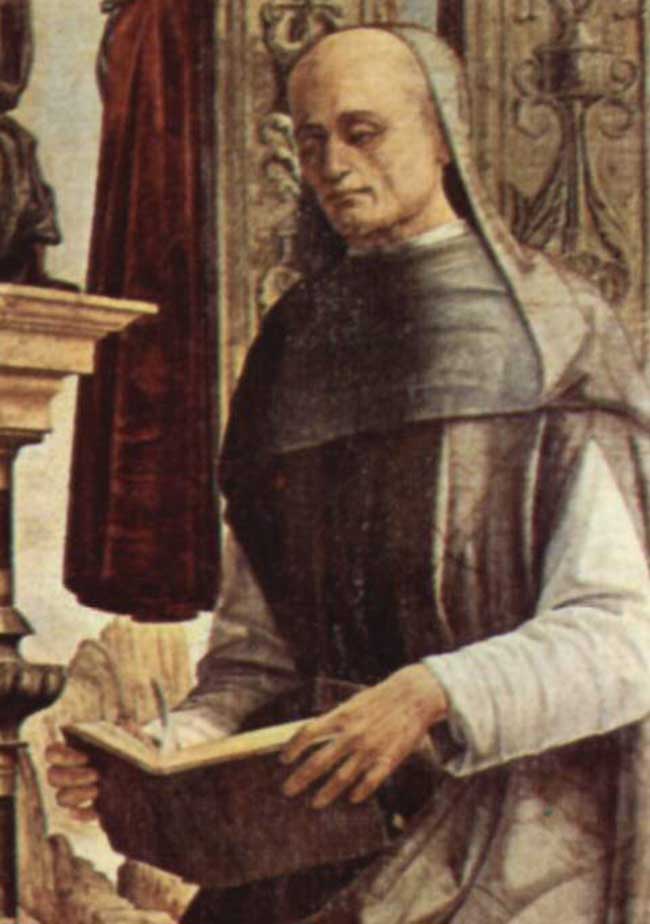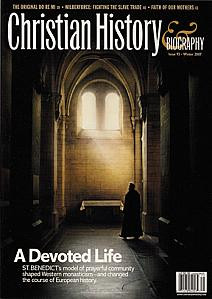PETER DAMIAN WANTED A RETIRED LIFE BUT POPES FORCED HIM INTO ACTION

[Above: Detail of Peter Damian from a painting by Ercole de' Roberti Portuense-Altar, Szene: Thronende Madonna und Heilige: Hl. Augustinus, Hl. Anna, Hl. Elisabeth, Hl. Petrus Damiani —The Yorck Project (2002) 10.000 Meisterwerke der Malerei (DVD-ROM), distributed by DIRECTMEDIA Publishing GmbH. ISBN: 3936122202. / public domain, Wikimedia.]
DISGUSTED with the scandals around him, Peter Damian abandoned a promising career as a teacher at Ravenna to enter a Benedictine hermitage. The year was around 1035 and he was probably not yet thirty years old. Impressed with the conversation of two hermits he met by “chance,” Damian buried himself in isolation at Fonte Avellana in the lovely region of Gubbio, Italy. However, because he was an expert in rhetoric, theology, and canon law, the church would not allow him to remain sequestered.
Born c. 1007, “five years after the death of the Emperor Otto III,” he was the youngest of at least six siblings. His mother for a time refused to nurse him, so that he almost died. Orphaned young, he was raised by two older brothers, the first of whom abused him, fed him little, and employed him as a swineherd. Another brother, a priest, recognized his intelligence, rescued him from this situation, and arranged for his education.
As a scholar Damian applied himself assiduously and was soon a well-known teacher. After he entered the hermitage, he wrote at least one hundred and eighty letters. Some of them, although couched in the form of epistles, were actually lengthy tracts. His first such tract, Against the Jews (c. 1040), suggested how to answer Jewish questions about Christianity and their attacks on the Trinity.
Fonte Avellana had been founded by followers of St. Romuald, and Damian wrote the saint’s life (1042, one of seven such lives). The following year he became prior of the hermitage and held the position the remainder of his life. He promoted self-flagellation and applied it to himself, along with fasting and vigils, with such rigor that he seriously undermined his own health and gave himself insomnia. He really seems to have believed that each blow to his own body would shave a specified amount of time off his stay in Purgatory.
He continued to write. In Liber Gomorrhianus (Book of Gomorrah, c. 1050) he urged the ideal of celibacy and criticized clerical marriages and homosexuality. Liber gratissimus (Most-Favoured Book, c. 1052) pushed back against simony—the buying and selling of church positions. His most famous letter, however, was the lengthy De divina omnipotentia (On Divine Omnipotence, 1065) in which he argued God can do any good thing, but that God’s self-consistency keeps him from reversing the past.
Pope Stephen IX made Damian a cardinal in 1057. Damian had just recovered (miraculously, he believed) from a seven-week illness. He resisted the appointment but the pope overrode his objections. Thereafter Damian would work closely with Cardinals Humbert, Silva Candida, and Hildebrand to reform the church. He helped prepare a decree on papal elections, attended several synods, and carried out embassies for popes to arbitrate regional disputes. He met with Henry IV of Germany to urge him not to divorce his wife, Bertha.
Damian died on this day, 22 February 1072,* at Fonte Avellana. He had just returned from Ravenna where he tried to settle a rift between his home town and Rome. His writings and reform-minded labors helped set the tone of the medieval church. Seven and a half centuries later, in 1823, Pope Leo XII pronounced him a doctor of the church.
—Dan Graves
* Some say 23 February.
----- ----- -----
Damian was a Benedictine. For more on Benedict and his rule, consult Christian History #93, A Devoted Life: St. Benedict & Western Monasticism






